This was our last day at the site and there was still quite a bit to do. There was still some excavating to complete and all of the final documentation of the site to do – and it takes a LOT more time than I had anticipated!
But before we could begin our last day of work – Ben, Mike and I headed down to the beach at 5 am, stirred up the campfire and waited for the satellite phone to have a signal so we could call in to the Webinar. We managed to get a signal around 5:15 that lasted about 13 minutes! We hope those of you that called in enjoyed the webinar and if you missed it – check out the archive!
Our departure time was "after lunch”. The day before, Shelby and I had worked to finish cataloging and tagging the last of the samples and artifacts as they came down from the site and packed up the lab tent supplies. We also sorted the large bags of artifacts into coolers and salvaged crates from the beach for transport to and storage back on the ship.
Since we were already up, Mike, Ben, Bre and I headed up to the site to get started before breakfast. We still had to finish excavating the last bit of Unit 4, do archaeological profiles for the walls of three units, Bre had to do geologic section descriptions for one or two units, all of the walls and floors had to be cleaned for final photographs and then the final samples of tephra and charcoal needed to be taken. This, in addition to breaking down the entire camp!
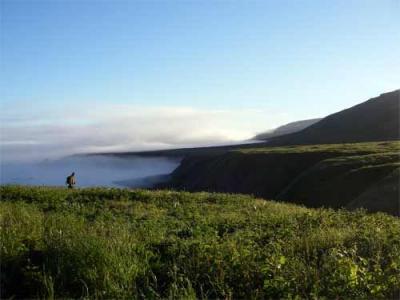 Mike Etnier looks back at the beautiful morning scenery after climbing up to the terrace to work on the Vodapadnaya excavation before breakfast on our last day at the site.
Mike Etnier looks back at the beautiful morning scenery after climbing up to the terrace to work on the Vodapadnaya excavation before breakfast on our last day at the site.
*Mike Etnier looks back at the beautiful morning scenery after climbing up to the terrace to work on the Vodapadnaya excavation before breakfast on our last day at the site. It was only sunny on the day we arrived and on the day that we left…. *
I was very impressed with the amount of "extra” documentation of the site that occurs after the digging is done! It reminded me that scientists often record more data, observations or details than they immediately need for their project or experiment. They anticipate what other sorts of information they might need later on when they are NOT at that field location or like in this case where the observations are reburied below a meter of dirt. That way they are more likely to have all of the information that they need and anything that a future scientist might be interested in knowing about the site as well. It’s like a scientific insurance policy!
The first two tasks could be done in parallel simultaneously. The archaeologists worked in teams of two to draw profile maps of the stratigraphy in each wall of every excavation unit. This involved placing two thin stakes into the wall with a level string stretched between. The depth of the string below the secondary datum was measured and recorded. Then the vertical distance up or down of each layer of in the soils – tephra layers, cultural layers, areas with heavy charcoal accumulation, etc – was measured at several places along the string. That way a dotted line could be drawn across the drawing and connected to roughly give the curved outline of the layer. This was done for each layer that could be distinguished in the wall.
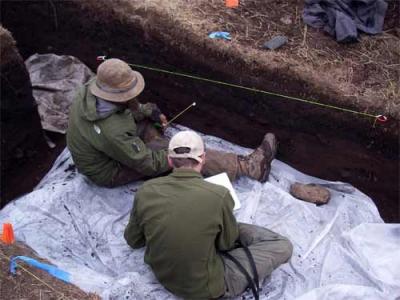 James Taylor and Matt Walsh work to draw an archaeological stratigraphic profile map of the north wall of Unit 1 at the Vodapadnaya excavation site. The yellow line along the wall has been leveled and measured against the secondary datum point so that the depths of each layer can be matched up to others on each drawing.
James Taylor and Matt Walsh work to draw an archaeological stratigraphic profile map of the north wall of Unit 1 at the Vodapadnaya excavation site. The yellow line along the wall has been leveled and measured against the secondary datum point so that the depths of each layer can be matched up to others on each drawing.
James Taylor and Matt Walsh work to draw an archaeological stratigraphic profile map of the north wall of Unit 1 at the Vodapadnaya excavation site. The yellow string along the wall has been leveled and measured against the secondary datum point so that the depths of each layer can be matched up on each drawing.
At the same time, Bre MacInnes and I worked to do the geologic cross section descriptions for each wall. Bre would find a representative point on the wall, pin her measuring tape to the wall and then give a verbal description of the stratigraphy that I would record in her field notebook. The description would include the general width of the layer, its color and grain size. Any other details of importance such as grading by size, variability of width, color or composition across the wall, etc. would be also noted. Later these observations are converted into a colored diagram.
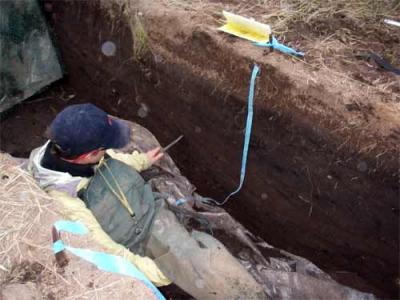 Bre MacInnes gives a geologic cross section description of the north wall of Unit 1 at the Vodapadnaya excavation site. She uses the measuring tape to determine depth and her knife to find small changes in grain size. All of her observations are recorded and later converted into a colored drawing that can be correlated to other locations.
Bre MacInnes gives a geologic cross section description of the north wall of Unit 1 at the Vodapadnaya excavation site. She uses the measuring tape to determine depth and her knife to find small changes in grain size. All of her observations are recorded and later converted into a colored drawing that can be correlated to other locations.
Bre MacInnes gives a geologic cross section description of the north wall of Unit 1 at the Vodapadnaya excavation site. She uses the measuring tape to determine depth and her knife to find small changes in grain size. All of her observations are recorded and later converted into a colored drawing that can be correlated to other locations.
After ALL of the profiling and describing is completed, any marks on the walls are gently removed, the protective plastic is removed and the floors are given a final gentle scrape to clear away any loose dirt. Then the wall and floor of each unit in the entire excavation is photographed with scale rods for documentation.
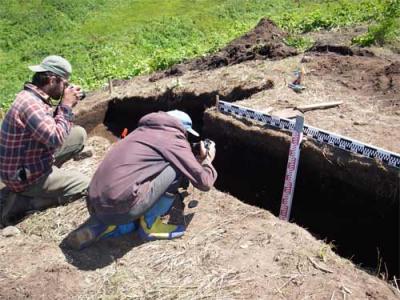 Ben Fitzhugh and Valery Shubin take photographs of the cleaned walls at the Vodapadnaya excavation site before it is filled back in with dirt.
Ben Fitzhugh and Valery Shubin take photographs of the cleaned walls at the Vodapadnaya excavation site before it is filled back in with dirt.
Ben Fitzhugh and Valery Shubin take photographs of the cleaned southern wall of Unit 1 at the Vodapadnaya excavation site before it is filled back in with dirt.
Then before the site is filled back in with dirt, two final things are done. First, samples of charcoal and tephra are taken from the walls. The tephra samples are done after the pictures because taking the sample makes a sizable hole in the wall. The charcoal samples provide redundancy with samples that were taken previously during the excavation process and can be correlated to the tephra samples. This can also help to assign approximate dates to the volcanic eruptions and cultural occupation periods.
Then the walls and floor of the site are lined with a protective barrier. In this case, a large piece of fish net that has been cut into long strips was used to line the walls and floors. The netting has two purposes: to protect the walls from damage and give them additional support against caving in and to identify the floor, or the "end”, of this excavation for other archaeologists in the future who may return to this site for more work.
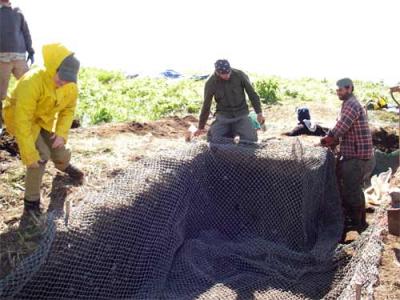 Dani Plante, Matt Walsh and Ben Fitzhugh work to line the walls and floor of the Vodapadnaya excavation with a large piece of fish net that was scavenged from the beach. This will protect the side walls from disturbance and help scientists who might return to do further digging find the bottom of this excavation.
Dani Plante, Matt Walsh and Ben Fitzhugh work to line the walls and floor of the Vodapadnaya excavation with a large piece of fish net that was scavenged from the beach. This will protect the side walls from disturbance and help scientists who might return to do further digging find the bottom of this excavation.
Dani Plante, Matt Walsh and Ben Fitzhugh work to line the walls and floor of the Vodapadnaya excavation with a large piece of fish net that was scavenged from the beach. This will protect the side walls from disturbance and help scientists who might return to do further digging find the bottom of this excavation.
While all of this was happening, the field camp was also being broken down. Personal gear and tents were packed, as well as the lab tent and cook tent, and then staged on the beach for transport back to Iskatel – which had been anchored a bit offshore since the night before.
At just after 3:15 pm, the entire excavation crew gathered at the site with shovels in hand to begin the job of backfilling. All of the dirt that had been removed from the site and that hadn’t been washed away with the wet screening had been placed into a large pile next to the excavation. Quickly, within 45 minutes, the entire site had been covered with as much dirt as we could salvage and the pieces of coherent sod that we could still locate.
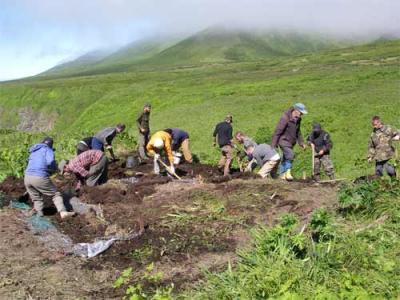 The entire crew works to fill in the Vodapadnaya excavation site with dirt from the pile that was removed from the units now that the excavation is complete.
The entire crew works to fill in the Vodapadnaya excavation site with dirt from the pile that was removed from the units now that the excavation is complete.
The entire crew works to fill in the Vodapadnaya excavation site with dirt from the pile that was removed from the units now that the excavation is complete.
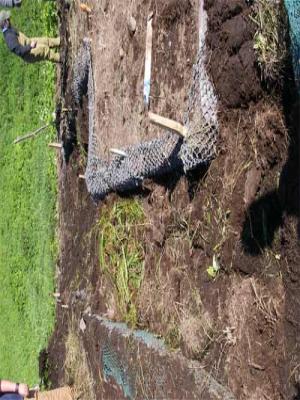 The Vodapadnaya excavation site after it has been lined with fish netting and reburied with back dirt. Our work here is done!
The Vodapadnaya excavation site after it has been lined with fish netting and reburied with back dirt. Our work here is done!
*The Vodapadnaya excavation site after it has been lined with fish netting and reburied with back dirt. Our work here is done! *
By 4 pm we were back down on the beach, waiting to assist the loading of many zodiac trips back and forth from the ship that would be required to transport us and all of our gear back to warm showers and the opportunity to create some clean clothes. We would all be back in shore camp again in a few days. (And for me it was much sooner that anticipated!)
Da Svidanya! Misty

